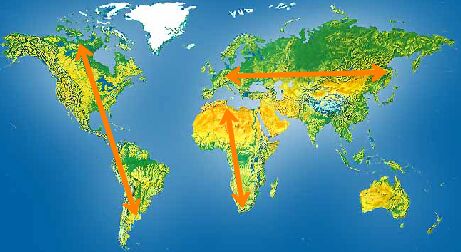 |
| Jared Diamond's "matrix" of the spread (or not) of inventions. |
Guns, Germs, and Steel: The Fates of Human Societies
by Jared Diamond
Published July 17, 2005
528 pages
Setting:
World
Time Period: Human
origins to modern, concentrated from 13,000 B.C. to 1900 A.D.
Subject Headings: Social
evolution, Civilization – History, Ethnology
Type: Science
Series notes: n/a
Book summary: The
author dismantles racially based theories of human history by revealing the
environmental factors he feels are responsible for history's broadest patterns. (Worldcat, 2017)
Reading elements: Thought-provoking,
informative, detailed, sweeping scope, well-researched and documented, documentary-like
Annotation: A
thought-provoking look at the ultimate (not proximal, he really harps on this distinction) causes of human civilization patterns throughout
history, arguing that more highly developed societies resulted from geographic,
environmental, and political factors rather than genetic or racial factors.
Similar works: Salt by Mark Kurlansky; 1491: New Revelations of the Americas Before Columbus
by Charles C. Mann
1.
Where is the book on the narrative continuum? Highly fact-based
2.
What is the subject of the book? Exploring the reasons why some cultures/societies
have developed and/or been more dominant than others
3.
What type of book is it? Anthropological exposition - Science
4.
Articulate appeal.
a.
Pacing:
Highly detailed, slow reading as explanations build to conclusions, in-depth
thinking
b.
Describe the characters of the book: No particular characters, this book is
idea-based
c.
How does the story feel? Philosophical, like an exploration of
ideas, documentary
d.
What is the intent of the author? To persuade the reader of the validity of
his hypothesis
e.
What is the focus of the story? To explain ultimate causes of why particular
societies have thrived more than others
f.
Does the language matter? Yes
g.
Is the setting important and
well-described? Yes. Geographical considerations play a very large
role in this essay and these factors are described in detail
h.
Are there details, and if so, what? Yes, lots.
About geographic, political, and other factors that either contributed
or hindered human development
i.
Are there sufficient charts and other graphic
materials? Are they useful and
clear? Not many, but they are clear
j.
Does the book stress moments of learning,
understanding, or experience? Yes,
understanding is stressed throughout the book.
5.
Why would a reader enjoy this book?
a.
Explores big ideas
b.
Thought-provoking about the haves and have-nots
c.
Clear, in-depth explanations which are
well-supported and well-argued
Good prompt response. Minor deduction for lateness.
ReplyDelete